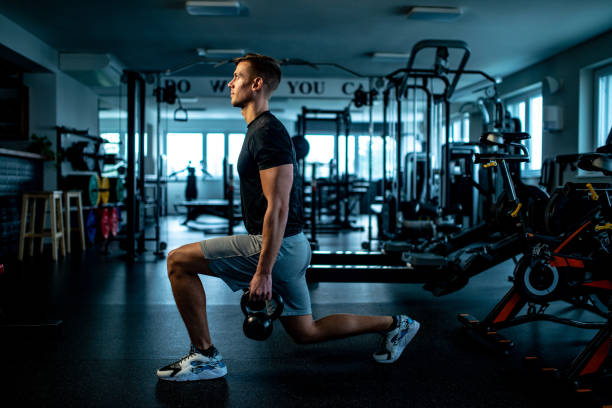Incorporating side lunges, also known as lateral lunges, into your leg-day routine at Gold’s Gym can be highly beneficial. Side lunges involve stepping to the side and lowering your hips, thereby engaging various leg muscles and improving joint stability.
How to Do Side Lunges
To perform a side lunge, follow these steps:
- Stand with feet together, hands clasped in front of your chest.
- Take a large step out to the left and sink your hips back while bending your left knee, lowering into a lunge. Keep your right leg straight but not locked and ensure that both feet are pointing forward.
- Push through your left foot to straighten your left leg, bring it next to your right leg, and then go back to the starting position.
The Key Side Lunge Benefits
Incorporating side lunges into your routine provides several benefits, including:
It Challenges Your Body in the Frontal Plane of Motion
Most daily movements involve the sagittal plane, which consists of forward or backward movements. However, it’s essential to train your body in other planes of motion, such as the frontal plane, which includes side-to-side movements. Side lunges help you practice lateral movement patterns, improving stability, mobility, and balance. This is particularly important for activities like standing on a moving subway, where frontal plane stability is crucial.
It Helps Correct Muscle Imbalances
Regularly performing exercises that target one side of your body at a time helps prevent muscle imbalances. Side lunges work one side of your body in the frontal plane, activating smaller muscles in the inner and outer thighs that may be overlooked in sagittal plane exercises. By addressing muscle imbalances, you reduce the risk of compensatory movement patterns and potential injuries.
It Strengthens Your Ankle Joints
The lateral movement pattern in side lunges strengthens the ankle joints, reducing the risk of ankle sprains. Ankle sprains often occur on the lateral side, and by building strength in this area, you enhance stability during workouts and everyday activities. Strong ankles also help prevent pain and discomfort in the knees and hips since these joints are interconnected.
Muscles Developed in Side Lunges
Side lunges engage various muscles in your legs, including:
- Hip adductors
- Hip abductors
- Quads, hamstrings, and core
Side Lunge Variations
To add variety to your workouts, consider the following side lunge variations:
Modification: Chair Sit Side Lunge
If you’re concerned about the impact of a traditional lateral lunge, try a cossack squat instead. This exercise involves shifting your weight into one foot and sinking into a squat while keeping the other leg straight. You can also use a chair as support during the side lunge, ensuring proper form and making it easier to return to a standing position.
Progression: Side Lunge with Explosive Push
To increase the difficulty of the traditional side lunge, you can try the side lunge with an explosive push. After lowering into the lunge, explosively push off the ground to return to a standing position. This recruits more muscles and adds a cardiovascular component to the exercise. You can also challenge your stability by adding a single-leg balance at the end of each rep. Instead of returning your foot back to the starting position, lift your knee up to your chest, creating a balance challenge.
Common Side Lunge Mistakes
When performing side lunges, it’s important to avoid common mistakes that can compromise your form and effectiveness. Some of these mistakes include:
- Dropping your chest – Maintain an upright posture with a proud chest and a neutral, flat back throughout the movement. This ensures proper engagement of your core muscles.
- Knee cave-in and heel lift – Ensure that your knee doesn’t collapse inward and that your heel on the working leg remains grounded. If these issues arise, it may indicate weakness in your hip abductors, and exercises to strengthen these muscles should be prioritized.
- Lack of intention and excessive impact – Move with intention and avoid aggressive impact, especially if you’re new to side lunges. Gentle stepping and controlled movements will minimize the risk of ankle or joint injuries.
Learn more about side lunges here:
